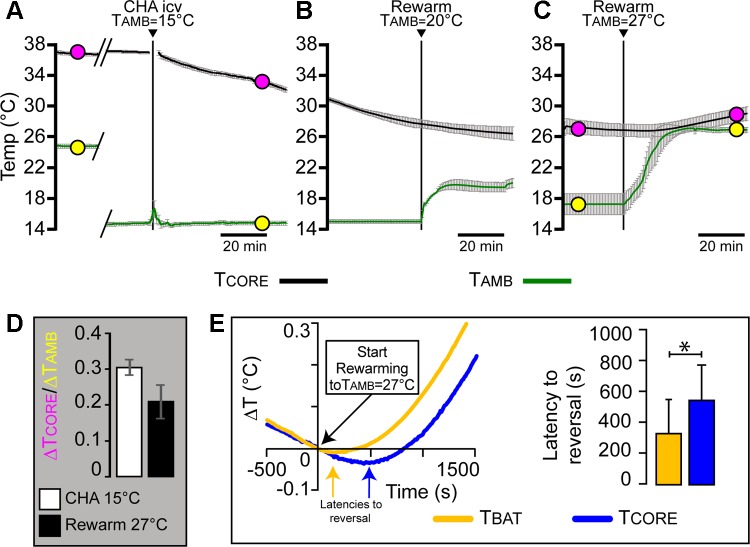Fig. 3.
Activation of central A1 adenosine receptors (A1AR) induces a deeply hypothermic state characterized by a thermoregulatory inversion. A: time courses (1-min bins) of the mean ± SE body core temperature [(TCORE; top traces (black)] and ambient temperature [TAMB; bottom traces (green)] records from 6 awake, free-behaving rats during the onset of the hypothermia induced by the intracerebroventricular (icv) administration (arrowhead) of the A1AR agonist CHA after a reduction of TAMB to 15°C, which occurred during the trace breaks (diagonal lines). B: time courses of the mean ± SE TCORE (black) and TAMB (green) records from 3 free-behaving, intracerebroventricular, CHA-treated rats during a skin rewarming with a TAMB of 20°C. C: time courses of the mean ± SE TCORE (black) and TAMB (green) records from 6 free-behaving, intracerebroventricular, CHA-treated rats during a skin rewarming with a TAMB of 27°C. Filled circles (A and C) indicate the pairs of simultaneous TCORE (pink) and TAMB (yellow) values used to calculate the gain (ΔTCORE/ΔTAMB; D) of the skin cooling response (A) and skin warming response (C) transfer functions in CHA-treated rats. The positive sign of the gain of the thermoregulatory response transfer function is a hallmark of thermoregulatory inversion. E: representative example (left) of the time courses of the TBAT (yellow trace) and TCORE (blue trace) surrounding the time point (time 0) at which TAMB began to increase. The latency to the reversal of the TBAT (yellow arrow) was ~340 s shorter than that of the TCORE (blue arrow). The mean (n = 4) latency to the reversal of the decline in TBAT was significantly (*P < 0.05) shorter than that in TCORE, consistent with an activation of BAT thermogenesis that preceded the increase in TCORE.

